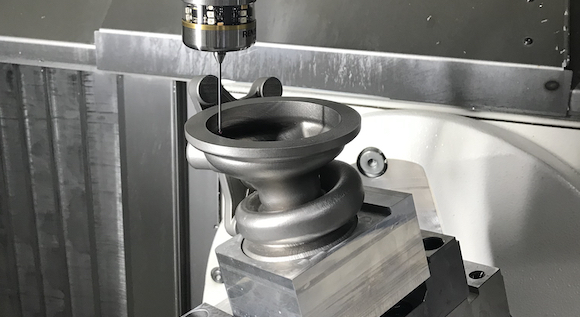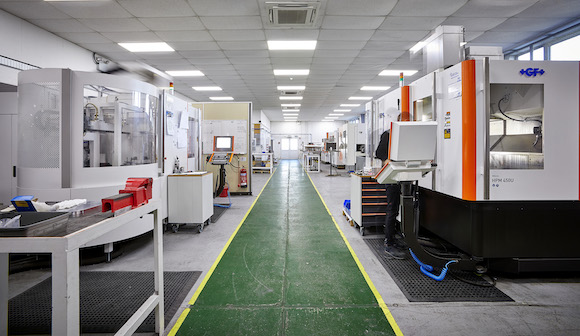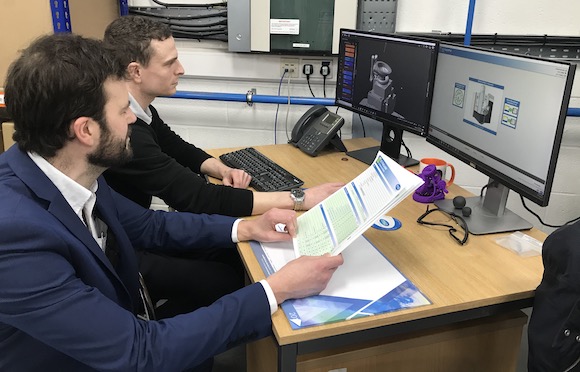3T-am cuts part setup time from five hours to ten minutes with Renishaw and MSP
June 30, 2020

3T Additive Manufacturing Ltd (3T-am), Newbury, UK, has achieved a reduction in its part setup time from five hours to ten minutes with the adoption of technology from Renishaw PLC, Wotton-under-Edge, Gloucestershire, UK, and Renishaw associate company MSP, Alnwick, Northumberland, UK.
3T-am, formerly 3T RPD, offers metal and polymer Additive Manufacturing services to a wide range of industries, primarily using Laser Beam Powder Bed Fusion (PBF-LB). It offers supply chain solutions providing parts that reduce volume weight, cost and lead time whilst maintaining safety through prototype, development and serial production.
3T-am has experienced strong growth in recent years, and while originally known for its prototyping capabilities, has more recently become established as a serial production company. As a result, the company is looking to expand its capability and capacity to meet customer demand.
Though it has always delivered orders on time, due to its meticulous and lengthy setup processes, operators were often required to work unplanned overtime shifts in order to fulfil urgent customer orders and meet quick turnaround times. To ease this pressure, the company made significant investments in two 5-axis mills and a CMM, but despite this extra capacity, each part still required manual setup, and, therefore, created additional demand on their manufacturing personnel to deliver parts on schedule.
By automating 3T-am’s processes, MSP has made it possible for the company to complete setup and alignment for a full batch of parts in the machine during the day and leave the machine to run overnight with full confidence. This has enabled 24/7 lights-out production, allowing the company to maximise its machine utilisation and produce a whole batch of parts in one day, compared to only one part previously.
The need for automation at 3T-am

3T-am’s ambition was to produce right-first-time parts, but the company found that this would be impossible without automation due to the inherent challenges posed by Additive Manufacturing. Their production to near-net shape means there is little material to work with, giving no margin of error, and they are usually complex shapes with no orthogonal surfaces to locate on, making it difficult to achieve accurate alignments. Furthermore, the AM build process can cause parts to distort, meaning their final shape may be marginally different to the initial CAD model.
Before introducing MSP’s products, 3T-am manually located each part in the fixture. This was a highly skilled and very time consuming process to ensure the alignment was accurate. Test spotting cuts were made to visually identify positional error, and the part was then either manually adjusted again or updates to the machining program were made. This manual setup process took, on average, five hours per part, but for more complex parts could sometimes take a day.
Once the initial part had been machined, a first article inspection on the CMM was performed before the rest of the batch could be manufactured. For a complex part, this inspection process could check in excess of sixty features, and it would only be at this stage that errors were discovered, meaning that the setup process needed adjustments and causing delay in the manufacture of the other parts. Even if the part passed inspection, the machine tool had in the meantime sat unused waiting for the inspection result.
Furthermore, the length of the process meant jobs were passed between operators and engineers changing shifts, which resulted in extensive technical handovers to safeguard the alignments needed on each job. For more complex parts, a ‘one job, one man’ method was used to avoid key information being missed; however, this made part manufacture solely dependent on one person and their working shifts, potentially resulting in excessive overtime and pressure for this engineer.
Martin Jarvis, Production Engineer at 3T-am, stated, “Our manual setup was high risk and we had low confidence. We would be nervous when the finished part was taken to inspection as our day’s work could be written off and we would need to do an expensive single part rebuild and fast track it through production to ensure it was delivered on time – that was a problem.”
Solving the problem with Renishaw and MSP

3T-am turned to Renishaw and MSP to help reduce setup times, improve quality and automate their processes in order to make full use of their pallet changing system for lights-out production and maximise machining capacity.
The use of Renishaw’s OMP600 high-accuracy machine tool probe and MSP’s NC-PerfectPart software allows 3T-am to identify and correct errors in part positioning and machine performance prior to machining. The OMP600 offers all the benefits of automated job setup, as well as the ability to measure complex 3D part geometries and, in combination with MSP’s software, automate machining processes and eliminate the potential for human error.
NC-PerfectPart’s initial step is to assess the machine tool’s geometric performance to ensure it is calibrated and correct in 5-axis movement. This confirms every aspect of the probe and machine performance is within set tolerances prior to part setup and machining, to ensure that parts can be finished accurately.
The part is securely loaded into the machine and the software then measures it to calculate an accurate best fit alignment in 6º of freedom. The controller is automatically updated to compensate for the discrepancy between the physical part location and the nominal machining program, to ensure the machining path takes place where the real part is.
This eliminates the need to carefully fixture and adjust the part manually. Crucially, any misalignment errors are automatically removed and the time taken to align or locate the part is significantly reduced.
The same measurements are then used by the software to check the part’s condition of supply. It produces a Pre-Machining Inspection Report, which notes if there is too much distortion or not enough material to create a ‘good part’ or ‘clean up’ in the areas which are to be machined. This is generated before any machining begins, so the part process can be stopped from the outset if any condition of supply errors are present.
NC-PerfectPart’s ability to automate part alignment and take measurements at any tool orientation, in any direction, also allows for simple, generic work holding to be used, as the fixture is only required to securely hold the part. This removes the need for expensive bespoke location fixtures and allows the same fixture to be used for multiple parts (where applicable).
At the end of the process, using NC-PerfectPart, the part can be inspected on the machine before it is removed from the fixture and a Post-Machining Verification report is produced which verifies the part has been machined within tolerance. This reduces reliance on the CMM, eradicating CMM bottlenecks and gives the ability to automate the inspection process.
“I challenged MSP to prove their claims in real time as it all seemed too good to be true,” stated Jarvis. “I attended Renishaw’s Innovation Centre in Gloucester and presented the MSP engineer with a completely blind test. I turned up with a part which they had no advance knowledge of, and they programmed the part and delivered the promised results before my eyes. When MSP’s products were installed at 3T-am, the MSP guarantee also meant we were making right-first-time parts before their engineer even left site.”
Operator and Programmer at 3T-am, Jon Saunders, added, “As well as the great results, we have been very pleasantly surprised by how straightforward MSP’s software has been for us to use day to day. The automation gives us the certainty we always wanted that the parts are going to be right.”
“The impact has been huge for us in terms of our working practices and the confidence we now have in delivering what we do,” commenced Jarvis. “It has almost made me want to get back out working on the shop floor.”
















